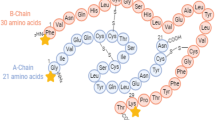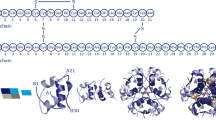Abstract
Human insulin was fluorescently labelled with fluorescein isothiocyanate (FITC) and the conjugate species produced were identified using high performance liquid chromatography and electrospray mass spectroscopy. Mono-labelled FITC-insulin conjugate (A1 or B1) was successfully produced using human insulin at short reaction times (up to 5 h) however the product always contained some unlabelled native human insulin. As the reaction time was increased over 45 h, no unlabelled native human insulin was present and more di-labelled FITC-insulin conjugate (A1B1) was produced than mono-labelled conjugate with the appearance of tri-labelled conjugate (A1B1B29) after 20 h reaction time. The quantities switch from mono-labelled to di-labelled FITC-insulin conjugate between reaction times 9 and 20 h. In the presence of phenol or m-cresol, there appears to be a 10 % decrease in the amount of mono-labelled conjugate and an increase in di-labelled conjugate produced at lower reaction times. Clinically used insulin analogues present in commercially available preparations were successfully fluorescently labelled for future biomedical applications.






Similar content being viewed by others
References
Lavis LD, Raines RT (2008) Bright ideas for chemical biology. ACS Chem Biol 3(3):142–155
Jameson DM, Ross JA (2010) Fluorescence polarization/anisotropy in diagnostics and imaging. Chem Rev 110(5):2685–2708
Giepmans BN, Adams SR, Ellisman MH, Tsien RY (2006) The fluorescent toolbox for assessing protein location and function. Science 312(5771):217–224
Ueno T, Nagano T (2011) Fluorescent probes for sensing and imaging. Nat Methods 8(8):642–645
Choi J, Kang S, Kim H, Um SH, Shin K, Choi J, et al. (2013) Dye-doped silica nanoparticle with HIV-1 TAT peptide for bioimaging. J Biomed Nanotechnol 9(2):291–294
Shelma R, Sharma CP (2013) In vitro and in vivo evaluation of curcumin loaded lauroyl sulphated chitosan for enhancing oral bioavailability. Carbohydr Polym 95(1):441–448
Rodríguez-Sáinz C, Valor L, Hernández DC, Gil J, Carbone J, Pascual-Bernaldez M, et al. (2013) Flow cytometry analysis with a new FITC-conjugated monoclonal antibody-3E12 for HLA-B*57:01 rapid screening in prevention of abacavir hypersensitivity in HIV-1–infected patients. HIV Clinical Trials 14(4):160–164
Maggi V (1966) The localization of fluorescent insulin in mouse tissues. Exp Cell Res 44(2):672–676
Tietze F, Mortimore GE, Lomax NR (1962) Preparation and properties of fluorescent insulin derivatives. Biochim Biophys Acta 59(2):336–346
Ciencialová A, Žáková L, Jiráček J, Barthová J, Barth T (2004) Preparation and characterization of two LysB29 specifically labelled fluorescent derivatives of human insulin. J Pept Sci 10(7):470–478
Bromer WW, Sheehan SK, Berns AW, Arquilla ER (1967) Preparation and properties of fluoresceinthiocarbamyl insulins*. Biochemistry (N Y) 6(8):2378–2388
Hentz NG, Richardson JM, Sportsman JR, Daijo J, Sittampalam GS (1997) Synthesis and characterization of insulin-fluorescein derivatives for bioanalytical applications. Anal Chem 69(24):4994–5000
De Meyts P (2004) Insulin and its receptor: structure, function and evolution. BioEssays 26(12):1351–1362
Schaffer L (1994) A model for insulin binding to the insulin receptor. Eur J Biochem 221(3):1127–1132
Menting JG, Whittaker J, Margetts MB, Whittaker LJ, Kong GK, Smith BJ, et al. (2013) How insulin engages its primary binding site on the insulin receptor. Nature 493(7431):241–245
Whittaker L, Hao C, Fu W, Whittaker J (2008) High-affinity insulin binding: insulin interacts with two receptor ligand binding sites. Biochemistry (N Y) 47(48):12900–12909
Liu F, Kohn WD, Mayer JP (2012) Site-specific fluorescein labeling of human insulin. J Pept Sci 18(5):336–341
Berenson DF, Weiss AR, Wan Z, Weiss MA (2011) Insulin analogs for the treatment of diabetes mellitus: therapeutic applications of protein engineering. Ann N Y Acad Sci 1243(1):E40–E54
Brange J, Langkjaer L (1993) Insulin structure and stability. Pharm Biotechnol 5:315–350
Whittingham JL, Jonassen I, Havelund S, Roberts SM, Dodson EJ, Verma CS, et al. (2004) Crystallographic and solution studies of N-lithocholyl insulin: a new generation of prolonged-acting human insulins. Biochemistry (N Y) 43(20):5987–5995
Havelund S, Plum A, Ribel U, Jonassen I, Vølund A, Markussen J, et al. (2004) The mechanism of protraction of insulin detemir, a long-acting, acylated analog of human insulin. Pharm Res 21(8):1498–1504
Acknowledgments
We thank EPSRC National Mass Spectrometry Facility, Swansea University for their help with FITC-insulin analysis. D Jacob would like to acknowledge the research studentship provided by De Montfort University.
Author information
Authors and Affiliations
Corresponding author
Rights and permissions
About this article
Cite this article
Jacob, D., Joan Taylor, M., Tomlins, P. et al. Synthesis and Identification of FITC-Insulin Conjugates Produced Using Human Insulin and Insulin Analogues for Biomedical Applications. J Fluoresc 26, 617–629 (2016). https://doi.org/10.1007/s10895-015-1748-1
Received:
Accepted:
Published:
Issue Date:
DOI: https://doi.org/10.1007/s10895-015-1748-1




